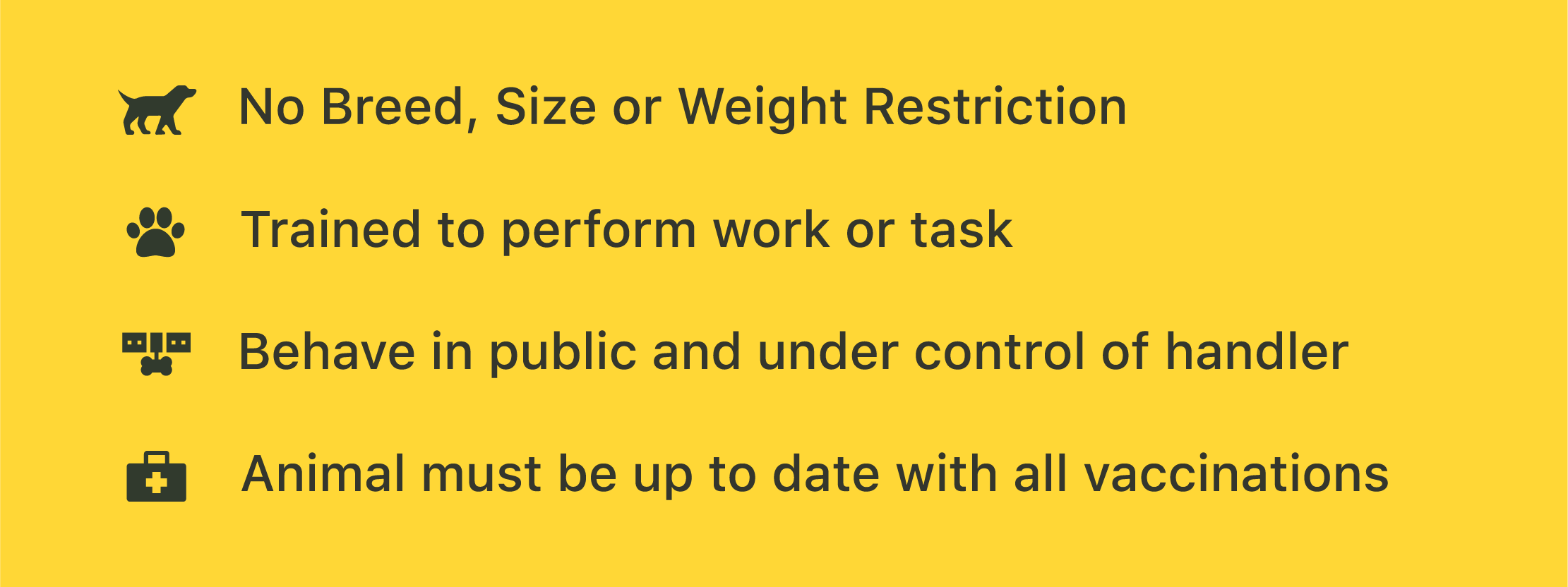 Certified Course
Certified Course  Accredited Course
Accredited Course  Accepted by Airlines
Accepted by Airlines○ Understand Your Puppy’s Behavior;
○ Form A Strong Bond with Your Dog;
○ Retrieve Based Tasks;
○ Alert to Specific Sounds;
○ Deposit Based Tasks;
○ Obedience and Public Access Manners;
○ Pawing Based Tasks;
○ Other Kinds of Assistance in Crisis
Find the complete learning plan in the Syllabus below.
Special Enrollment Price
Originally: $798
Now Only: $479
Save $319 Today


Money back guarantee within 14 days*

Are you looking to train your own puppy to become a service dog? If you have answered yes, our Bundle will provide you with valuable tips on how to train your puppy to become a service dog, as successful early training and bonding will make later service dog training much simpler.
The Intensive Service Dog Training Course and the Service Puppy Training Program are a combo for owners who are adopting a puppy in order to train them to become a service dog.
Our courses are developed by the SDTSI team of trusted, experienced behavioral experts, including certified trainers and board-certified veterinary behaviorists. The programs will help you build a solid foundation and gain a better understanding of your dog as an individual, his/her body language, strengths, weaknesses, as well as of your own needs. You and your paw friend will be able to spend valuable time together and strengthen your bond. Having the feeling that you are the only one who is in control of your own life can not be compared with anything else!
The ISD course is spread over 8 distinct modules, covering everything you need to learn about training a service dog for a wide range of impairments and being a service dog handler. The Service Puppy Training Program is divided into 5 modules, designed to prepare your service dog puppy for both basic obedience and advanced tasks.
If you want us to be a part of your training journey, you can participate in our training program by following three easy steps: Enroll, Study, and Get Certified. There are no long waiting lists or periods to sweat out!
Sign up and get started today; you'll be amazed at what you and your dog can achieve!
Individuals who suffer from mental illnesses such as PTSD, Panic Disorder, Anxiety, Depression, Mental Abuse, etc., who are in the process of training their own pet dog to become a service dog to deal with their psychiatric disabilities, or who are planning to adopt or pick out a dog and train them to become a psychiatric service dog in the near future.
We generally recommend psychiatric service dogs be owner-trained with professional guidance from our tutor trainer, because psychiatric service dogs need to establish a particular bond with the user to most effectively mitigate disabling symptoms. Being in contact with the dog makes it possible for the dog to learn to recognize (and then respond to) departures from an individual’s baseline emotional or physiological state.
The most significant difference between SDTSI's owner-self online service dog training course and those of other companies is the evaluation and certify process that we provide. SDTSI is focusing only on service dog training; all of our trainers have passed the Level 3 Diploma in Assistance Dog Training and Canine Behaviour & Training Technician (CBTT) program. They are either certified trainers by the American Kennel Club or certified assistance dog trainers by Canine Behaviour College UK. Our online training programs and trained service dog certificates are not only valid in the US and parts of Canada, but also in most parts of Europe and the UK. Our program offers detailed instruction, evaluation, and guidance on all aspects of the process required to train and certify your own dog to become a qualified service dog with legal documentation. Be cautious of online service dog training companies that are mainly selling doctor letters or service dog registrations service and use misleading messages.
receive a very well-behaved service dog and a Certificate issued by Service Dog Training School International: Service Dog Certificate. To view a sample of the award, please click here. A digital copy of the certificate will be delivered to your email inbox within 24 hours.
Your dog partner will be Certified as a Service Dog with all the training records by ServiceDog Training School International.
It means your dog has been trained to perform the work or task as a service dog.
The primary purpose of certification is to ensure that your dog is fully trained as a service dog and its handler understands how to lead its Assistance Dog/Service Dog through everyday situations, such as going to a shop, a park, a hospital, a care home or any other public places.
Session 1
- Things to Consider When Before Getting a Puppy
Session 2
- Understand Your Puppy
- Body Language Dictionary
- Dog Psychology
- Social Behavior
- Dog Senses
Session 3
- Puppy Cares and Nutrition
- Top Dangerous Food for Dogs
- DIY Dog Food From SDTSI Certified Pet Food Nutrition Specialist
Session 4
- Potty Training
Session 5
- First 5 Steps to Train Your Service Dog Puppy
- Build Puppy Confidence and Further Training Examples
Session 6
- Starting a Schedule for Your Puppy
- 5 Puppy Daily Routine Elements to Consider
- Example Puppy Daily Schedule Chart
- Dealing with Behavioral Issues
Conclusion
1 - Introduction
2 - Service Dog History
3 - Types of Service Dogs and What They Do
4 - Things Handlers Should Know
5 - Abilities and Limitations of Your Service Dog
6 - Canine Communication - Interpreting Dog Body Language
7 - Puppy Testing
8 - Basics for All Service Dogs
9 - How a Dog Learns
10 - Encouraging Your Dog
11 - Equipment for Training
12 - The Basic Vocabulary and Core Words for Service Dogs
13 - First Five Things to Teach
14 - Eye Contact Training
15 - Focus Training
16 - Barking, Speak Up and Be Quiet Training
17 - Finding and Retrieving Tricks
18 - Opening and Closing
19 - Paw-push Targeting
20- Allergen Detection
21 - Standing Up and Pushing a Cart
22 - Extended Training - Adding Drama with Clever Tricks
23 - Public Access Test
24 - Aircraft Training
At the end of each training session, our tutor team will conduct an online evaluation of your training progress. You will be asked to complete a quiz and submit photos and videos of your dog performing specific tasks and exhibiting proper public behaviors. This method of continual assessment ensures that your personal trainer can consistently monitor your training progress, provide you with assistance throughout the course, and prepare you for final certification and public testing.
All study materials
⊛ 8 lessons
⊛ 18 videos
⊛ 8 exams
⊛ 7hrs 36m time to complete
⊛ Certificate upon completion
Study and Training Guide
Full Tutor and Admin support
The course fee includes the printable service dog certificate. The digital copy will be sent within 24 hours upon successful course completion.